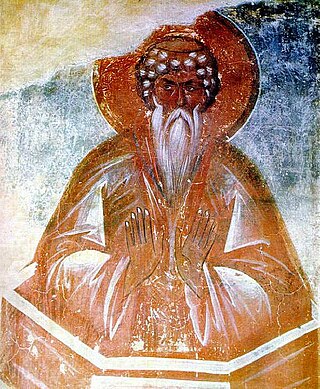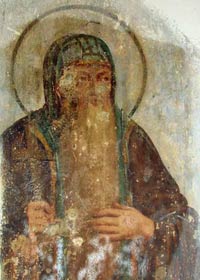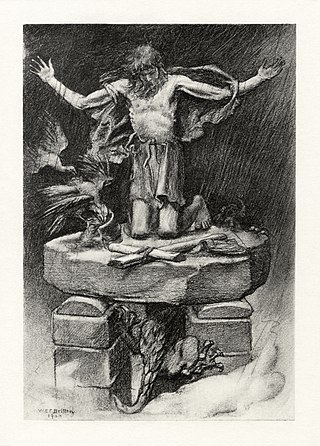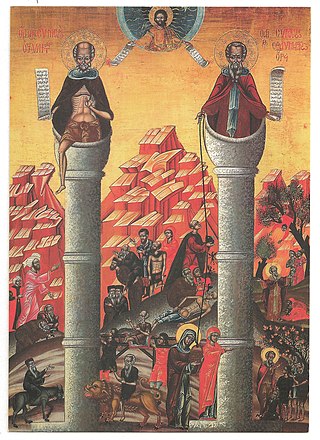Related Research Articles

A patron saint, patroness saint, patron hallow or heavenly protector is a saint who in Catholicism, Anglicanism, or Eastern Orthodoxy is regarded as the heavenly advocate of a nation, place, craft, activity, class, clan, family, or person.
Acacius served as the Ecumenical Patriarch of Constantinople from 472 to 489. He was practically the first prelate in all of Eastern Orthodoxy, and was renowned for his ambitious participation in the Chalcedonian controversy.
John of Ephesus was a leader of the early Syriac Orthodox Church in the sixth century and one of the earliest and the most important historians to write in Syriac. John of Ephesus was a bishop, but John was more important than other bishops and what sets him apart from most others is the fact that he was a historian and a writer. He was also a political man and would often follow his own path. John was seen as a great writer and covered important aspects of events in history, and one of these important events was the plague, and John has one of the only first-hand accounts of the plague. He was also alive in what has been called the worst year in history, 536.

Jacob of Serugh, also called Mar Jacob, was one of the foremost Syriac poet-theologians, perhaps only second in stature to Ephrem the Syrian and equal to Narsai. Where his predecessor Ephrem is known as the 'Harp of the Holy Spirit', Jacob is the 'Flute of the Holy Spirit' in Antiochene Syriac Christianity. He is best known for his prodigious corpus of more than seven-hundred verse homilies, or mêmrê, of which only 225 have thus far been edited and published.

Simeon Stylites or Symeon the Stylite was a Syrian Christian ascetic, who achieved notability by living 37 years on a small platform on top of a pillar near Aleppo. Several other stylites later followed his model. Simeon is venerated as a saint by the Oriental Orthodox, Eastern Orthodox, and Roman Catholic Churches. He is known formally as Simeon Stylites the Elder to distinguish him from Simeon Stylites the Younger, Simeon Stylites III, and Symeon Stylites of Lesbos.

Aug. 31 - Eastern Orthodox liturgical calendar - Sep. 2

Saint Simeon Stylites the Younger, also known as Simeon of the Admirable Mountain, is a saint in the Catholic Church and Eastern Orthodox Church.

Daniel the Stylite is a saint and stylite of the Eastern Orthodox, Roman Catholic and Eastern Catholic Churches. He is commemorated on 11 December according to the liturgical calendars of these churches.
Western Rite Orthodoxy, also called Western Orthodoxy or the Orthodox Western Rite, are congregations within the Eastern Orthodox tradition which perform their liturgy in Western forms.

Eastern Christian monasticism is the life followed by monks and nuns of the Eastern Orthodox Church, Oriental Orthodoxy, the Church of the East and Eastern Catholicism. Eastern monasticism is founded on the Rule of St Basil and is sometimes thus referred to as Basilian.

Venerable Luke the Stylite lived in Constantinople in the 10th century.

Saint Alypius the Stylite was a seventh-century ascetic saint. He is revered as a monastic founder, an intercessor for the infertile, and a protector of children. During his lifetime he was a much sought-after starets.
Saint Ephraim of Antioch, also known as Saint Ephraim of Amida, was the Patriarch of Antioch, and head of the Chalcedonian Patriarchate of Antioch, from 527 until his death in 545. He is venerated as a saint in the Eastern Orthodox and Catholic Churches. His feast day is 8 June.

The Church of Saint Simeon Stylites is one of the oldest surviving church complexes, founded in the 5th century. It is located approximately 30 kilometres (19 mi) northwestern of Aleppo, Syria. It was constructed on the site of the pillar of Saint Simeon Stylites, a renowned stylite monk. The church is popularly known as either Qalaat Semaan or Deir Semaan.

Athanasius of Brest is a saint and hieromartyr of the Russian Orthodox Church and the Polish Orthodox Church. He was killed by Catholics for opposition to the Union of Brest. Athanasius is commemorated on September 5.

Venerable Nicetas (Nikita) Stylites was a 12th-century Russian saint who founded the Monastery of St. Nicetas on the eastern shore of Lake Pleshcheyevo in Zalesye.

"St Simeon Stylites" is a poem written by Alfred Tennyson in 1833 and published in his 1842 collection of poetry. The poem describes the actions of St. Simeon Stylites, a Christian ascetic saint who recounts his various physical acts in hopes that he has earned his place in heaven. It captures Tennyson's feelings following the death of a close friend, Arthur Hallam, and contains feelings of self-loathing and regret. The work has ironic overtones that give it the appearance of a satirical work.

A stylite or pillar-saint is a type of Christian ascetic who lives on pillars, preaching, fasting and praying. Stylites believe that the mortification of their bodies would help ensure the salvation of their souls. Stylites were common in the early days of the Byzantine Empire. The first known stylite was Simeon Stylites the Elder who climbed a pillar in Syria in 423 and remained there until his death 37 years later.
Zoora was a Syrian Miaphysite monk and stylite in the Roman Empire. He moved to Constantinople in the early 530s and was condemned at the Council of Constantinople in 536. He died a few years later.
References
- Holweck, F. G. A Biographical Dictionary of the Saints. St. Louis, Missouri, United States: B. Herder Book Co., 1924.